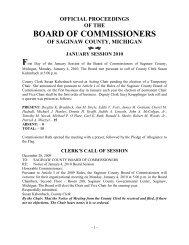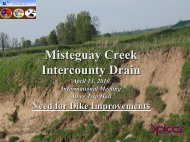The Metropolitan Transportation Planning ... - Saginaw County
The Metropolitan Transportation Planning ... - Saginaw County
The Metropolitan Transportation Planning ... - Saginaw County
You also want an ePaper? Increase the reach of your titles
YUMPU automatically turns print PDFs into web optimized ePapers that Google loves.
<strong>The</strong> <strong>Metropolitan</strong> <strong>Transportation</strong> <strong>Planning</strong> Process: Key Issues<br />
<strong>The</strong> MPO has two choices if it cannot make a conformity determination: 1) it can<br />
change the mix of projects in the transportation plan/TIP in an attempt to meet the<br />
conformity requirements or 2) it can request a SIP revision of the motor vehicle<br />
emissions budget.<br />
Under the metropolitan transportation planning requirements of TEA-21, projects in<br />
air quality nonattainment and maintenance areas cannot be approved, funded,<br />
or implemented unless those projects are included in a conforming (and fiscally<br />
constrained) long-range transportation plan and TIP. This means that the funding<br />
necessary to implement the long-range transportation plan is reasonably expected<br />
to be available over the 20-year plan period, and that funding for the first two years<br />
of the TIP is available or committed.<br />
What funding is available for air quality improvement programs and<br />
projects?<br />
Under the CMAQ program, States receive funding based on the severity of<br />
pollution and the population by county of each nonattainment and maintenance<br />
area. Additional funding is given to areas that violate both the ozone standard and<br />
the carbon monoxide standard. Each state receives CMAQ funding and then<br />
allocates funds, at the State’s discretion, to the air quality nonattainment and<br />
maintenance areas.<br />
How much money does the MPO receive each year in CMAQ<br />
funding?<br />
Each year, the amount of funding any individual MPO receives varies depending<br />
on the following factors: severity of pollution, population, whether both the ozone<br />
standard and the CO standard are violated, and the State’s method for allocating<br />
the funds. <strong>The</strong> FHWA posts the annual population numbers in each nonattainment<br />
and maintenance area, and the weighting formula for the apportionments of<br />
CMAQ funding, on its website at:<br />
http://www.fhwa.dot.gov/environment/cmaqpgs/index.htm<br />
What types of projects are funded with CMAQ funding?<br />
CMAQ funding is reserved for projects that reduce congestion and improve air<br />
quality. Typical projects include transit improvements, shared-ride services, traffic<br />
flow improvements, pedestrian and bicycle programs, construction of highoccupancy<br />
vehicle (HOV) lanes, I/M programs, and transportation demand<br />
management strategies. Guidance on the CMAQ program can be found at:<br />
www.fhwa.dot.gov/environment/cmaqpgs/index.htm<br />
Who decides which projects receive CMAQ funding?<br />
Decisions must be coordinated through the MPO planning process, and are made<br />
collaboratively by the MPO and state, subject to federal eligibility guidelines. <strong>The</strong>se<br />
guidelines are quite flexible, in order to promote innovation.<br />
What other sources of federal funding are there for air quality<br />
improvement projects?<br />
<strong>The</strong> Surface <strong>Transportation</strong> Program (STP) in TEA-21 allows states to use certain funds<br />
(known as "flex" funds) for a variety of projects, including transit, transportation<br />
demand management, and other strategies that will help to reduce emissions.



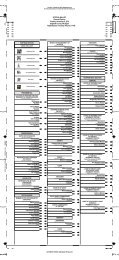
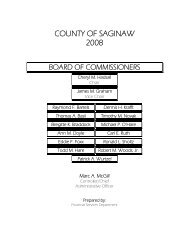
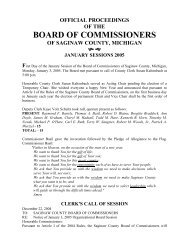
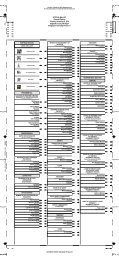

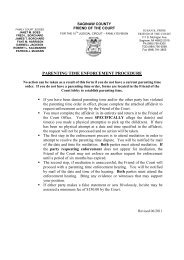
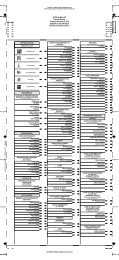


![[ Of Commissioners] - Saginaw County](https://img.yumpu.com/25951211/1/190x245/-of-commissioners-saginaw-county.jpg?quality=85)


